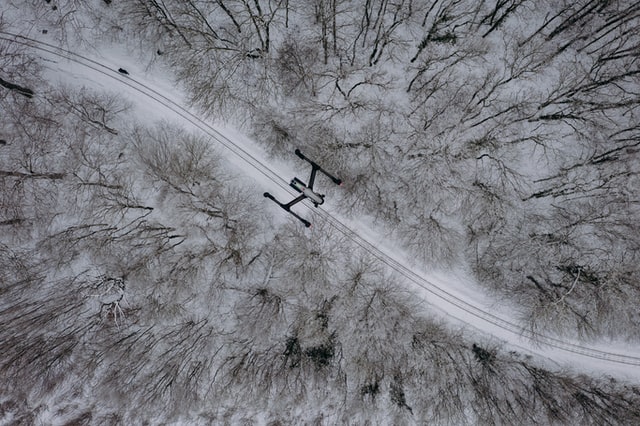Why does the wind ‘whistle’? Why is it less cold when it starts to snow? Find out about these and other curiosities about winter through the following gallery.
The winter is characterized as a station with shorter days, longer nights, and temperatures lower as we go away from the Earth in Ecuador. The further an area is from the equator, the colder the temperatures it will experience. Temperatures in equatorial regions remain relatively constant despite seasonal changes; this is because, due to the curvature of the Earth, equatorial areas get more sunlight, according to the Atmospheric Radiation Measurement (ARM) program. ).
It is the coldest season of the year, that without a doubt. However, most think that the coldest season begins during the winter solstice, there are two definitions for winter: astronomical winter and meteorological winter.
Thus, the astronomical winter, what we all know or consider as winter, is defined by the position of the Earth around the Sun and varies from the winter solstice to the spring equinox.
The winter solstice marks the time when the Sun passes directly over the equator. In the northern hemisphere, it occurs around December 21, and in the southern hemisphere, it occurs around June 21, according to the National Weather Service. We are facing the shortest day of the year and, therefore, it is usually celebrated by a great variety of cultures around the world.
At the time of the winter solstice, the corresponding pole is tilted about 23.5 degrees from the Sun. On that day, in the northern hemisphere, the North Pole is farther from our star, while in the southern hemisphere, it experiences the summer is closer.
On the other hand, the meteorological winter begins earlier, spanning the three-month period from December to March, according to NOAA (National Oceanic and Atmospheric Administration ), and is based on the annual temperature cycle and calendar, rather than the Earth’s journey around our sun.

Contents
Hypothermia
Cold winters can lead to life-threatening medical conditions, such as hypothermia. Hypothermia occurs when a person’s body temperature drops below 35 ° C, according to the Mayo Clinic. Low temperatures and wind chill can cause a person’s body temperature to drop in just a few minutes. Low temperatures can also cause frostbite, of the skin and tissues.
To avoid hypothermia and frostbite, it is important to keep all skin covered and dry during cold weather. Faced with hypothermia or frostbite, the first thing to do is warm the patient to increase his body temperature.
Earth is closer to the sun in winter
We have discussed it at the beginning. In the northern hemisphere, the Earth is closest to the sun during winter. Around January 3, the Earth reaches perihelion, being almost 5 million kilometers closer to the sun than in aphelion. When is it farthest from the Sun? Around July 5;
The fact that the Earth moves about 1 kilometer per second faster at perihelion than at aphelion, makes winter 5 days shorter than summer;
The whistle of the wind
Why do we hear that kind of hiss when it’s windy? It can not only happen in winter. The key is when the wind blows with great intensity. This force means that, in the event of encountering an obstacle in its path, the area of passage of the moving air narrows and accelerates, causing this particular hissing sound. Whether it is a crack in a door or a shutter, the wind will sneak through its small gaps and produce this sound.
Physical effects of winter
The seasons represent a powerful force in our lives and when winter comes – just like when summer happens – no one goes unnoticed. E l climate can have a profound impact on our health and our well-being. And science has found that it can affect a myriad of things: from creativity to our susceptibility to developing migraines. Thus, in a 2015 study published in The Journal of Headache and Pain, researchers asked 66 patients to provide daily headache reports for several months, finding that temperature-sensitive patients experienced significantly more pain. Headlong in winter compared to other seasons. The hypothesis is that these headaches may be related to blood vessels and circulatory changes, which the cold weather could aggravate.
Science has found a link between winter and depression, especially in patients suffering from seasonal affective disorder. This could be attributed to a number of reasons, such as that decreased sunlight can disrupt the body’s internal clock, leading to feelings of depression, or that the change of season may disrupt the balance of melatonin levels in the body, which plays a key role in sleep patterns and mood, according to experts from the Mayo Clinic in Rochester, Minnesota (USA). Surprisingly, a recent study published in the journal Behavioral and Brain Sciences concluded that violent thoughts tend to decrease during winter. since the levels of violence and aggression are higher in hot climates.
Why is it so much less cold when it snows?
We notice it every time it snows. We have that feeling that, although slightly, the environment seems more pleasant when it is snowing. For what reason; Science explains it to us. It turns out that snowflakes, made up of ice crystals, trap water vapor as they fall; that vapor ends up turned into ice, but of course, the passage from the gaseous state like water vapor to the solid-state like ice releases heat. Thus, each time it snows there is a significant release of heat into the atmosphere.
Effects of winter on sex
The arrival of winter is accompanied by a lower probability of sexual desire. Why do we have less desire for sex? Basically because the production of testosterone hormones declines from November to April in the Northern Hemisphere, and then rises steadily from spring and summer, with a notable peak in October. It is for this reason that reproduction rates increase with the month of June (it is the month with the highest conception rate). In addition, a study conducted by the University of Tasmania (Australia), suggested that the hibernation patterns of our ancestors are to blame for the drop in libido. “Hibernation slowed their metabolism and decreased sexual urges as they increased their caloric load and slept more,” explained Margaret Austen, a co-author of the study.
The calculation of the wind chill
How is the wind chill calculated? The cold or heat that we feel regardless of the real temperature is what we call thermal sensation and is determined by the environmental humidity, the speed, and direction of the wind, the cloudiness … in relation to the thermal difference between the skin and the combination temperature and wind. Thus, for example, if the thermometer shows 10ºC, the sky is clear and the wind is hardly blowing, it is likely that our thermal sensation is 7.5ºC.
Winter increases creativity
Feeling hot or cold can bring out different types of creativity. Thus, in a 2014 study published in Acta Psychological, researchers found that people who were given a hot therapy pad, a hot cup of tea, or who were in a room with a rather high temperature, were better at creative drawing, categorizing objects, and thinking of gift ideas for other people. On the other hand, those in the cold were better at identifying metaphors, coming up with new names, and planning abstract gift ideas. Researchers hypothesize that heat helps people feel psychologically connected and more generous with others, while cold can stimulate more abstract creativity since people tend to feel detached from others.
Why are cloudless nights in winter so cold?
The clouds have an incredible influence on Earth’s climate. Due to the fact that they are formed by a thick layer of water vapor, the cloud masses become solar filters that reflect much of the energy from the Sun into outer space. That is, the clouds make it difficult for the heat received during the day. Dissipates at night, so on cloudless days, temperatures drop dramatically, leading to frost.
Health consequences of cold
It is colder and, among other things, the cold is one of the causes that the rhinovirus (responsible for the common cold) spreads more, as many studies have already shown that the viruses that cause colds in humans replicate much more easily in cooler environments.
The darkness of winter
In winter we have much fewer hours of sun, this means that we receive less amount of sunlight compared to other months and our skin produces less vitamin D as a result. And we already know that vitamin D is very important in our body’s defenses, as it is involved in immune function, in the growth of cells and bones, and in the absorption of calcium from the body, among other things.
More germs spread in winter
The more people around us are sick, the more likely we are to catch it. Many times we usually cough or sneeze without being careful where we do it and we do not have the precaution of washing our hands afterward, this means that the germs expelled during coughing or sneezing can live peacefully on surfaces such as door handles, desks, and coffee makers. .. For two hours or even more;
The coldest town in the world
The municipality of Oymyakon (Russia) located in eastern Siberia, holds the record for the lowest temperature ever recorded in a place inhabited by man. This incredible temperature was -71.2ºC. According to the records, this record has been reached on two occasions: on February 11, 1895, and subsequently on January 10, 1982.
The lowest temperature recorded
Antarctica currently has the lowest temperature recorded. On August 10, 2010, scientists recorded a temperature of – 93.2 ° C) on the East Antarctic Plateau of Antarctica, according to NASA. The Soviet research station Vostok in Antarctica also recorded a very low temperature on July 21, 1983: -89ºC. In Prospect Creek, Alaska, the record was set on January 23, 1971, at -62ºC.
The great vision of the reindeer
Some reindeer that live in the Polar Circle live in complete darkness for several weeks of the year. To adapt to this dark situation, a small area of tissue behind the retina called the tapetum lucidum changes color. Golden in the summer months and blue in winter, allowing the reindeer’s eyes to detect ultraviolet light and see in the dark; the human eye does not have this quality, but many mammals such as dogs, bats, or horses do.
Animals in winter
Winter brings many changes to the world around you. During winter, some animals migrate, which means moving to another area for a season. Animals generally go south to warmer areas.
The movement of species also has to do with changes in habitat. The migration is not just about keeping warm, as some animals are forced to abandon their normal habitat due to changes in their food supply and the introduction of new bacteria or viruses (due to climate change) where they have little resistance.
Other animals begin a period of hibernation during the winter, spending most of the season almost asleep.
In addition to changing their locations and habits, some animals can also change their appearance. Animals like hares and foxes can change their coloration to blend in better in snowy landscapes or even get a thicker coat to maintain a warmer body temperature.
How much water is in the snow?
The exact amount of water contained in snow can vary significantly depending on how the snow was formed, but on average, 12 centimeters of snow would provide 1 centimeter of water.
Sometimes it snows where you least expect it
You wouldn’t be surprised to see snow on the ground in Siberia (Russia) or even Minnesota County (USA) when you travel to these places during the winter months. But these locations do not have a monopoly on snowfall; snow can touch from the Sahara desert to Hawaii. Even the driest place on Earth is not immune. In 2011, the Atacama Desert in Chile, for example, received almost 82 centimeters of snow thanks to a rare cold front from Antarctica.
Snow records
The city of Aomori in Japan is the city that supports more snowfall than any other on the planet. As a curiosity, on February 21, 2013, the official meteorological station of Japan registered the highest snowfall according to historical records dating back to 1977.
Chronophobia
Chronophobia is the fear of snow, especially if one is trapped by the snow. The term is derived from the Greek words chion and Phobos, which means “snow” and “fear”, respectively. It is one of the most curious phobias out there. People with xenophobia fear winter long before it begins, and constantly watch the weather channel or check the weather to monitor when a snowstorm might hit; its origin is normally due to a traumatic experience that has involved the presence of snow.
Curiosities about snowflakes
All snowflakes have 6 sides. They are symmetrical, transparent, and reflect light as if they were a luxury jewel.
According to Guinness World Records, on January 28, 1887, a 38-centimeter-wide and 20-centimeter-thick snowflake fell at Fort Keogh, Montana, making it the largest snowflake ever observed.
The average snowflake falls at about 4.8 km/hour.
A single blizzard can dump 39 million tons of snow.
Famous phrases about winter
“Now is the winter of our discontent.” William Shakespeare
“Laughter is the sun that drives winter away from the human face.” Victor Hugo
“Winter is not a season, it is an occupation”. Sinclair Lewis
“Winter is the time for comfort, good food and warmth, the touch of a friendly hand, and a chat by the fire – it’s time to go home.” Edith Sitwell
“You can’t get many winters in the winter.” Robert Frost
“What good is the warmth of summer, without the cold of winter to give it sweetness?” John Steinbeck
“Melancholy is the sounds on a winter night”. Virginia Woolf
Did you know that the temperature varies in each part of your body?
The normal body temperature is 36.6 ℃ averages, but there are variations of up to 0.5 ℃.
Our body reaches its peak temperature around 6 p.m. and drops to its lowest level around 4 a.m.
What is the warmest area of our body? The rectum (37 ℃), followed by the ears, urine, and mouth, and the coldest area; the armpit, with an average of 35.9 ℃;
There are also differences between men and women. The men have a higher average basal metabolic rate at rest (resting energy burned) due to their increased muscle mass, hence “manufactured” naturally amount of heat that usually women; that is why they tend to be more affected by low temperatures.







